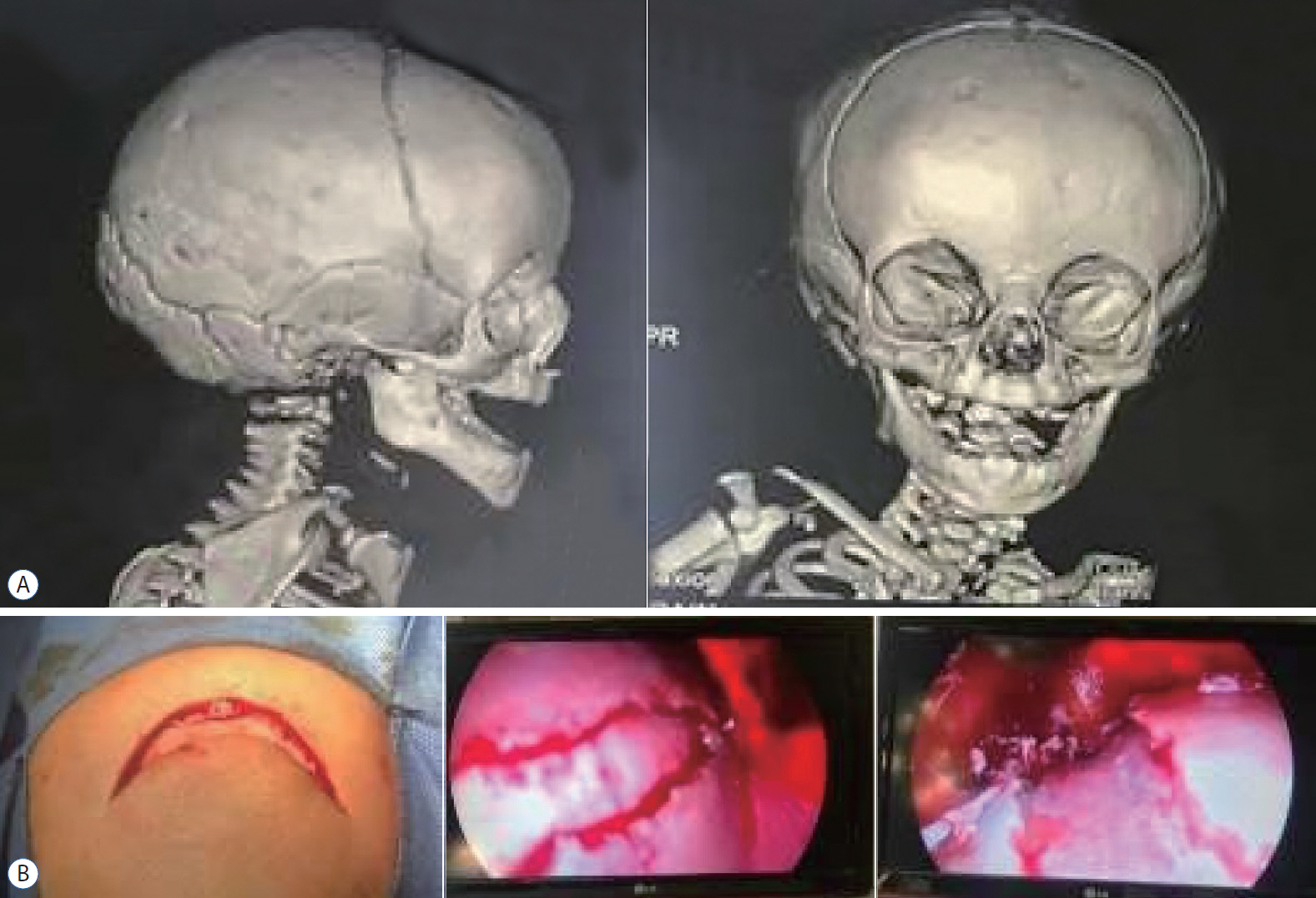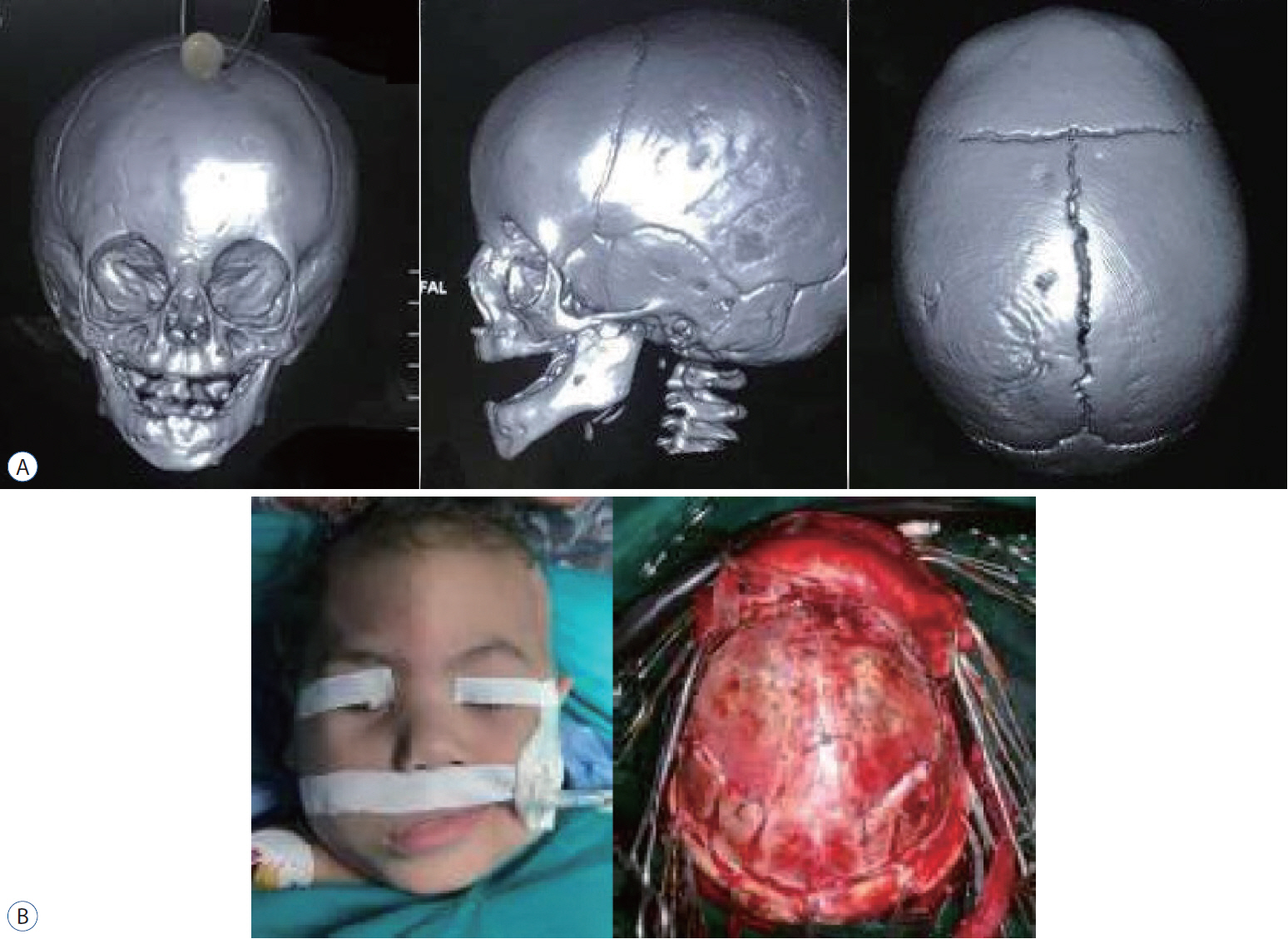J Korean Neurosurg Soc.
2022 Jan;65(1):107-113. 10.3340/jkns.2021.0034.
Outcomes of Surgical Management of Metopic Synostosis : A Retrospective Study of 18 Cases
- Affiliations
-
- 1Department of Neurosurgery, Benha University, Cairo, Egypt
- 2Department of Neurosurgery, Cairo University, Cairo, Egypt
- KMID: 2523918
- DOI: http://doi.org/10.3340/jkns.2021.0034
Abstract
Objective
: To describe the surgical management and postoperative outcomes in infants with metopic synostosis.
Methods
: We conducted a 5 years retrospective chart review of patients who underwent surgical correction of metopic synostosis at two university hospitals in Egypt during the period between June 2014 and June 2019. The study is conducted to 18 children. The type of surgical procedures and postoperative outcomes were assessed in all patients.
Results
: Five cases (27.8%) underwent endoscopic-assisted suturectomy, 10 cases (55.6%) underwent craniofacial reconstruction, and three cases (16.6%) underwent open burring of the metopic ridge. Fifteen patients underwent one surgery and three patients (16.6%) who need second operation. Ten patients (55.6%) had class I Whitaker classification.
Conclusion
: Regardless of type of surgery, the outcomes of surgical correction of metopic synostosis are excellent with only a few patients require revision or develop major complications.
Keyword
Figure
Reference
-
References
1. Arts S, Delye H, Van Lindert EJ. Intraoperative and postoperative complications in the surgical treatment of craniosynostosis: minimally invasive versus open surgical procedures. J Neurosurg Pediatr. 21:112–118. 2018.
Article2. Aryan HE, Jandial R, Ozgur BM, Hughes SA, Meltzer HS, Park MS, et al. Surgical correction of metopic synostosis. Childs Nerv Syst. 21:392–398. 2005.
Article3. Aryan HE, Meltzer HS, Gerras GG, Jandial R, Levy ML. Leptomeningeal cyst development after endoscopic craniosynostosis repair: case report. Neurosurgery. 55:235–237. discussion 237-238. 2004.
Article4. Bhatti-Söfteland M, Maltese G, Tarnow P, Wikberg E, Bernhardt P, Kölby L. The degree of surgical frontal volume correction in metopic synostosis determines long-term outcomes. J Craniofac Surg. 28:1161–1163. 2017.
Article5. Campbell JW, Albright AL, Losken HW, Biglan AW. Intracranial hypertension after cranial vault decompression for craniosynostosis. Pediatr Neurosurg. 22:270–273. 1995.
Article6. Clayman MA, Murad GJ, Steele MH, Seagle MB, Pincus DW. History of craniosynostosis surgery and the evolution of minimally invasive endoscopic techniques: the university of florida experience. Ann Plast Surg. 58:285–287. 2007.
Article7. Cohen SR, Dauser RC, Newman MH, Muraszko K. Surgical techniques of cranial vault expansion for increases in intracranial pressure in older children. J Craniofac Surg. 4:167–173. discussion 174-176. 1993.
Article8. Cohen SR, Persing JA. Intracranial pressure in single-suture craniosynostosis. Cleft Palate-Craniofacial J. 35:194–196. 1998.
Article9. Dhellemmes P, Pellerin P, Lejeune JP, Lepoutre F. Surgical treatment of trigonocephaly. Experience with 30 cases. Childs Nerv Syst. 2:228–232. 1986.10. Di Rocco F, Arnaud E, Marchac D, Vergnaud E, Baugnon T, Vecchione A, et al. Anterior fronto-orbital remodeling for trigonocephay. Childs Nerv Syst. 28:1369–1373. 2012.
Article11. Engel M, Thiele OC, Mühling J, Hoffmann J, Freier K, Castrillon-Oberndorfer G, et al. Trigonocephaly: results after surgical correction of nonsyndromatic isolated metopic suture synostosis in 54 cases. J Craniomaxillofac Surg. 40:347–353. 2012.
Article12. Gault DT, Renier D, Marchac D, Jones BM. Intracranial pressure and intracranial volume in children with craniosynostosis. Plast Reconstr Surg. 90:377–381. 1992.
Article13. Genitori L, Cavalheiro S, Lena G, Dollo C, Choux M. Skull base in trigonocephaly. Pediatr Neurosurg. 17:175–181. 1991-1992.
Article14. Glener AD, Allori AC, Shammas RL, Farjat AE, Marcus JR. Post-surgical relapse in metopic synostosis and limitations of the interfrontal angle as an outcome measure. J Craniofac Surg. 28:e494–e500. 2017.
Article15. Hilling DE, Mathijssen IM, Vaandrager JM. Aesthetic results of fronto-orbital correction in trigonocephaly. J Craniofac Surg. 17:1167–1174. 2006.
Article16. Jimenez DF, Barone CM. Early treatment of anterior calvarial craniosynostosis using endoscopic-assisted minimally invasive techniques. Childs Nerv Syst. 23:1411–1419. 2007.
Article17. Jimenez DF, Barone CM, Cartwright CC, Baker L. Early management of craniosynostosis using endoscopic-assisted strip craniectomies and cranial orthotic molding therapy. Pediatrics. 110(1 Pt 1):97–104. 2002.
Article18. Jimenez DF, Barone CM, McGee ME, Cartwright CC, Baker CL. Endoscopy-assisted wide-vertex craniectomy, barrel stave osteotomies, and postoperative helmet molding therapy in the management of sagittal suture craniosynostosis. J Neurosurg. 100(5 Suppl Pediatrics):407–417. 2004.
Article19. Kelleher MO, Murray DJ, McGillivary A, Kamel MH, Allcutt D, Earley MJ. Non-syndromic trigonocephaly: surgical decision making and long-term cosmetic results. Childs Nerv Syst. 23:1285–1289. 2007.
Article20. Keshavarzi S, Hayden MG, Ben-Haim S, Meltzer HS, Cohen SR, Levy ML. Variations of endoscopic and open repair of metopic craniosynostosis. J Craniofac Surg. 20:1439–1444. 2009.
Article21. Kim D, Pryor LS, Broder K, Gosman A, Breithaupt AD, Meltzer HS, et al. Comparison of open versus minimally invasive craniosynostosis procedures from the perspective of the parent. J Craniofac Surg. 19:128–131. 2008.
Article22. Lane LC. Pioneer craniectomy for relief of mental imbecility due to premature sutural closure and microcephalus. JAMA J Am Med Assoc XVIII. 18:49. 1892.
Article23. McCarthy JG, Glasberg SB, Cutting CB, Epstein FJ, Grayson BH, Ruff G, et al. Twenty-year experience with early surgery for craniosynostosis: II. The craniofacial synostosis syndromes and pansynostosis--results and unsolved problems. Plast Reconstr Surg. 96:284–295. discussion 296-298. 1995.24. Natghian H, Song M, Jayamohan J, Johnson D, Magdum S, Richards P, et al. Long-term results in isolated metopic synostosis: the Oxford experience over 22 years. Plast Reconstr Surg. 142:509E–515E. 2018.25. Nguyen KT, Cohen SR, Broder K. 72: variations in the surgical management of metopic synostosis: endoscopic-assisted, minimally invasive and open surgical treatment. Plast Reconstr Surg. 118:58. 2006.
Article26. Selber J, Reid RR, Gershman B, Sonnad SS, Sutton LN, Whitaker LA, et al. Evolution of operative techniques for the treatment of single-suture metopic synostosis. Ann Plast Surg. 59:6–13. 2007.
Article27. Thompson DN, Malcolm GP, Jones BM, Harkness WJ, Hayward RD. Intracranial pressure in single-suture craniosynostosis. Pediatr Neurosurg. 22:235–240. 1995.
Article28. Thompson DNP, Harkness W, Jones B, Gonsalez S, Andar U, Hayward R. Subdural intracranial pressure monitoring in craniosynostosis: its role in surgical management. Childs Nerv Syst. 11:269–275. 1995.
Article29. Tobias JD, Johnson JO, Jimenez DF, Barone CM, McBride DS Jr. Venous air embolism during endoscopic strip craniectomy for repair of craniosynostosis in infants. Anesthesiology. 95:340–342. 2001.
Article30. Whitaker LA, Bartlett SP, Schut L, Bruce D. Craniosynostosis: an analysis of the timing, treatment, and complications in 164 consecutive patients. Plast Reconstr Surg. 80:195–212. 1987.31. Winston K, Beatty RM, Fischer EG. Consequences of dural defects acquired in infancy. J Neurosurg. 59:839–846. 1983.
Article32. Wójcicki P, Prudel B. Trigonocephaly: long-term results after surgical correction of metopic suture synostosis. Adv Clin Exp Med. 28:625–635. 2019.
Article
- Full Text Links
- Actions
-
Cited
- CITED
-
- Close
- Share
- Similar articles
-
- A Case of DiGeorge Syndrome with Metopic Synostosis
- Surgical Treatment of Congenital Radioulnar Synostosis
- Surgical treatment of congenital radioulnar synostosis
- Correction of Congenital Metacarpal Synostosis with Polypropylene Mesh as an Interpositional Material
- A Report of congenital Radio - Ulnar Synostosis Occurred in Brothers: One Case Associated with Klinefelter's Syndrome




